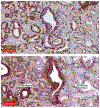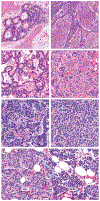Genomic and phenotypic heterogeneity in prostate cancer
- PMID: 33328650
- PMCID: PMC7969494
- DOI: 10.1038/s41585-020-00400-w
Genomic and phenotypic heterogeneity in prostate cancer
Abstract
From a clinical, morphological and molecular perspective, prostate cancer is a heterogeneous disease. Primary prostate cancers are often multifocal, having topographically and morphologically distinct tumour foci. Sequencing studies have revealed that individual tumour foci can arise as clonally distinct lesions with no shared driver gene alterations. This finding demonstrates that multiple genomically and phenotypically distinct primary prostate cancers can be present in an individual patient. Lethal metastatic prostate cancer seems to arise from a single clone in the primary tumour but can exhibit subclonal heterogeneity at the genomic, epigenetic and phenotypic levels. Collectively, this complex heterogeneous constellation of molecular alterations poses obstacles for the diagnosis and treatment of prostate cancer. However, advances in our understanding of intra-tumoural heterogeneity and the development of novel technologies will allow us to navigate these challenges, refine approaches for translational research and ultimately improve patient care.
Figures





References
Publication types
MeSH terms
Substances
Grants and funding
LinkOut - more resources
Full Text Sources
Medical

